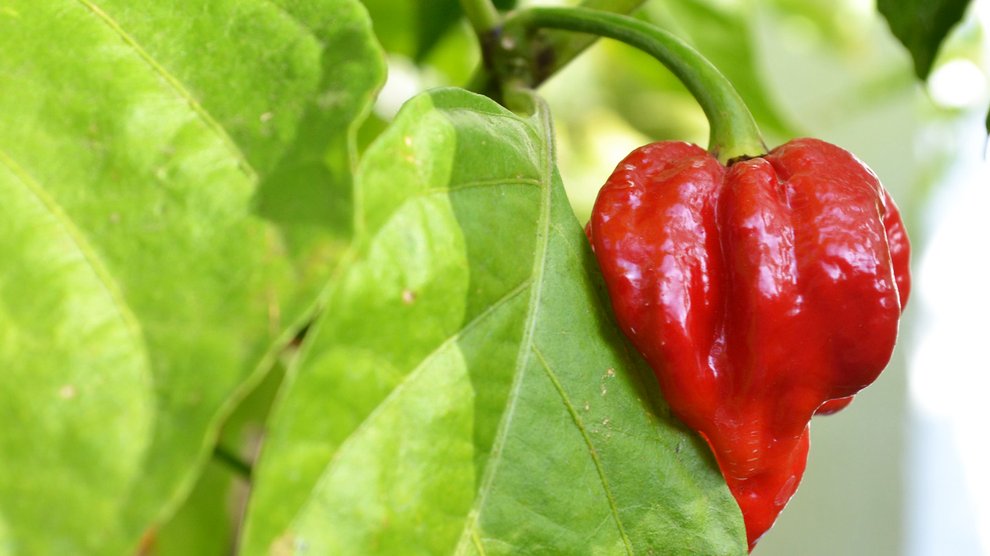From jumping horses to jalapeños: the science of spicy peppers
Discover capsaicin, the active ingredient in chile peppers. (If you can take the heat.)

Red hot chili peppers, and other hot peppers within the Capsicum genus, get their heat from the chemical capsaicin. Image credit: Austin Kirk, Flickr
A few months after competing in the 2008 Summer Olympics in Beijing, Norweigian horseback rider Tony André Hansen was stripped of his bronze medal. His horse Camiro had failed a drug test during the Games, testing positive for capsaicin. The International Equestrian Federation dismissed the pair, along with three other showjumping riders and horses, from the competition.
Hansen has not competed in the show ring since.
Capsaicin is the chemical responsible for the “heat” in chile peppers. Like many over-the-counter muscle rubs—think “IcyHot”—capsaicin can bring on both tingling sensitivity and numbness.
When applied as a paste or lotion to horses’ forelegs, capsaicin can cause a burning sensation that would be exacerbated by knocking against the rails of a jump. If a showjumping horse lifts its legs higher, it avoids the potentially irritating touch of a fence—and its rider avoids incurring penalties. But capsaicin can also soothe aches and pains by temporarily deactivating the nerve endings where it’s applied. An exhausted horse with numbed nerves will perform better than an equally tired one that can feel the full pain of its aching muscles, according to the American Association of Equine Practitioners, which is why capsaicin is banned from equestrian competitions to this day.
“Capsaicin binds to the TRPV-1 receptor—a pain receptor present all over our bodies,” says Ivette Guzmán, a horticulturist and member of the Chile Pepper Institute of New Mexico State University. If a horse is sore, “applying capsaicin binds up those pain receptors,” she says. A horse may feel a little bit of heat from topical capsaicin, but “they won’t feel the pain,” Guzmán explains. “It works on us, too.”
Just as horses experience a numbing feeling from a topical application of capsaicin, your tongue will tingle when you chew a hot pepper. This numbing sensation is often coupled with a burning one that’s enjoyed by spicy food-lovers around the world: Whether eating centuries-old cuisines like Indian curry or saucy chicken wings on the popular YouTube series “Hot Ones,” human beings have subjected themselves to the uncomfortable chemistry of capsaicin for millennia.
The need for heat
Pepper species native to the Americas fall within the genus Capsicum. Some Capsicum peppers, like the mild bell pepper, have no capsaicin at all. Others, like the jalapeño and habanero pepper—popular additions to dishes requiring some extra “heat”—do have the chemical. (A few Capsicum peppers, including the incredibly-hot ghost pepper, were developed in South Asia by hybridizing varieties from the Americas.)
“A lot of people mistakenly think the seeds are what hold the spice,” Guzmán says. But “capsaicin is found in the part of the fruit called the placenta: the membrane that holds onto the seeds.”
But spicy food doesn’t have to be hot to convey heat. In fact, capsaicin doesn’t physically burn your tongue and innards at all. When your body processes capsaicin, your nervous system sends out a response that activates your senses for touch and temperature. The same receptors responsible for blocking topical pain send signals to your brain that you’re being burned when you eat something spicy. And here’s the kick: Capsaicin alters the sensitivity of the pain receptors in your mouth, effectively lowering the temperature at which you feel burning pain. This is why jalapeño sauce feels burning hot even after being refrigerated.
“These [receptors] work really well when they detect the correct stimulus,” says Joanna Buckley, a chemist at the University of Sheffield in England. “They respond to anything over 43 C (109 F). So if you have a hot cup of tea, this receptor will work correctly and tell you, ‘Oh, your tea’s a bit hot.’”
The problem is, Buckley adds, these heat-sensing receptors are also triggered by a class of compounds called vanilloids. Capsaicin is one of them.
Chemically, capsaicin is corrosive (like hydrogen peroxide), acutely toxic (like chlorine), and irritating (like ammonia). And its irritant qualities won’t just fire up your mouth: Capsaicin can have a similar effect on other mucous membranes. If you’ve ever chopped peppers and then accidentally touched your eye, you understand how irritating this compound can be.
So why do some people enjoy—and even get a thrill out of—eating a fruit with such a kick?
“We get interviewed often by chiliheads,” Guzmán says. “I’m Mexican. I grew up eating jalapeños, I grew up eating really spicy food, and I understand that there are other chemicals in [peppers] that are medicinal. But when it comes to chiliheads, I think they’re fascinated by the chemistry of capsaicin and how it makes you feel something you’ve never felt before. It gives you a euphoria.”
Measuring that euphoria depends on the Scoville scale.
Let’s talk Scovilles
Named for American pharmacist Wilbur Scoville, the Scoville scale ranks the pungency of chile peppers based on the concentration of capsaicin in the pepper. It’s this concentration that determines how our bodies will react to peppers; while small amounts of capsaicin fall within the “spicy chicken dinner” category, stronger concentrations spell out “weapon-grade pepper spray.”
In the early 1900s, Scoville, who was working as a chemist at the time, attempted to test out people’s relative capsaicin tolerance. He recruited five human subjects to taste-test mixtures of dried pepper and sugar water and had them report how hot they found each mixture to be. The basis of his heat scale is the amount of sugar water needed to dilute the mixture enough for the majority of his subjects to no longer feel the heat.
These days, a technique called high-performance liquid chromatography is used to determine exactly how much capsaicin a pepper contains in parts per million, and multiplying the result by 16 converts it to Scoville Heat Units (SHUs).
The highest level of naturally occuring capsaicin is in the Carolina Reaper, the hottest pepper in the world. Its creator, chile pepper grower Ed Currie, bred the pepper by taking one uniquely spicy habanero grown on the La Soufrière volcano on Saint Vincent in the Caribbean and crossing it with a Naga Viper pepper, which was developed in the United Kingdom from peppers hailing from the Caribbean and South Asia. The hottest single Carolina Reaper ever to be harvested rang in at 2.2 million SHU, meaning that more than a tenth of the pepper was pure capsaicin.
High amounts of capsaicin, like those found in the Carolina Reaper, can cause injury. “Capsaicin is a really potent chemical. If you have too much of it, it can be toxic,” Buckley says. “It’s the thing that’s used in pepper spray. We’ve all seen images of people who have been pepper sprayed. Their eyes are swollen up, they’re crying, they can’t see…so it’s incredibly important to know how to handle capsaicin” safely, she says.
Your body’s battle against spice
If you don’t welcome spicy burns, there’s a way to neutralize the compound’s effects: dairy. “Capsaicin is an oil and it is insoluble in cold water,” Buckley says. Though it’s somewhat soluble in alcohol, like beer, Buckley explains, capsaicin is best dissolved by another oil. “You need to find something that’s fatty to dissolve the capsaicin,” she says. “That’s why the best thing to drink is milk.”
Although spicy food is sometimes associated with stomach problems—Currie, who not only created the Carolina Reaper but also eats one every day, still experiences severe stomach cramps—there is no direct evidence that spicy food causes belly cramps or nausea. The perceived pain, Guzmán explains, may just be a side effect of your gut membranes being irritated. While a 2016 study showed capsaicin can cause those with abdominal disorders to experience flare-ups in their symptoms, the same can be said for too much bread, a famously unspicy food.
But there are always worst-case scenarios.

A Trinidad moruga scorpion pepper, which is currently the second hottest pepper in the world to the Carolina reaper. Image credit: John Vonderlin, Flickr
More than 150 different varieties of chile grow in a garden at New Mexico State University’s Chile Pepper Institute. “One year we had a group of students we were doing a tour with in the garden. And one student thought it would be funny if he bit a tiny piece off a Trinidad Scorpion pepper,” Guzmán says. “He did that, and he threw up in the garden, and he passed out, and we had to carry him to a shaded area under some trees.”
Because capsaicin is a toxin, Guzmán explains, the human body’s first response to an excess of it is to flush it out. (In the student’s case, by vomiting.)
In 2018, the National Institutes of Health reported that a previously healthy 34-year-old man was admitted to the hospital with “thunderclap headaches”—sudden, severe head pain accompanied by fever, blurred vision, and even seizures—after eating a Carolina Reaper whole. Doctors treated him by flushing the capsaicin out of his body, which, like many chemical compounds in large amounts, can be dangerous.
Of course, Olympic equestrian Tony André Hansen’s story shows that even a small amount of this complex compound can be damaging (and in some cases, even career-ruining). It just depends on where—or upon whom—the capsaicin ends up.



